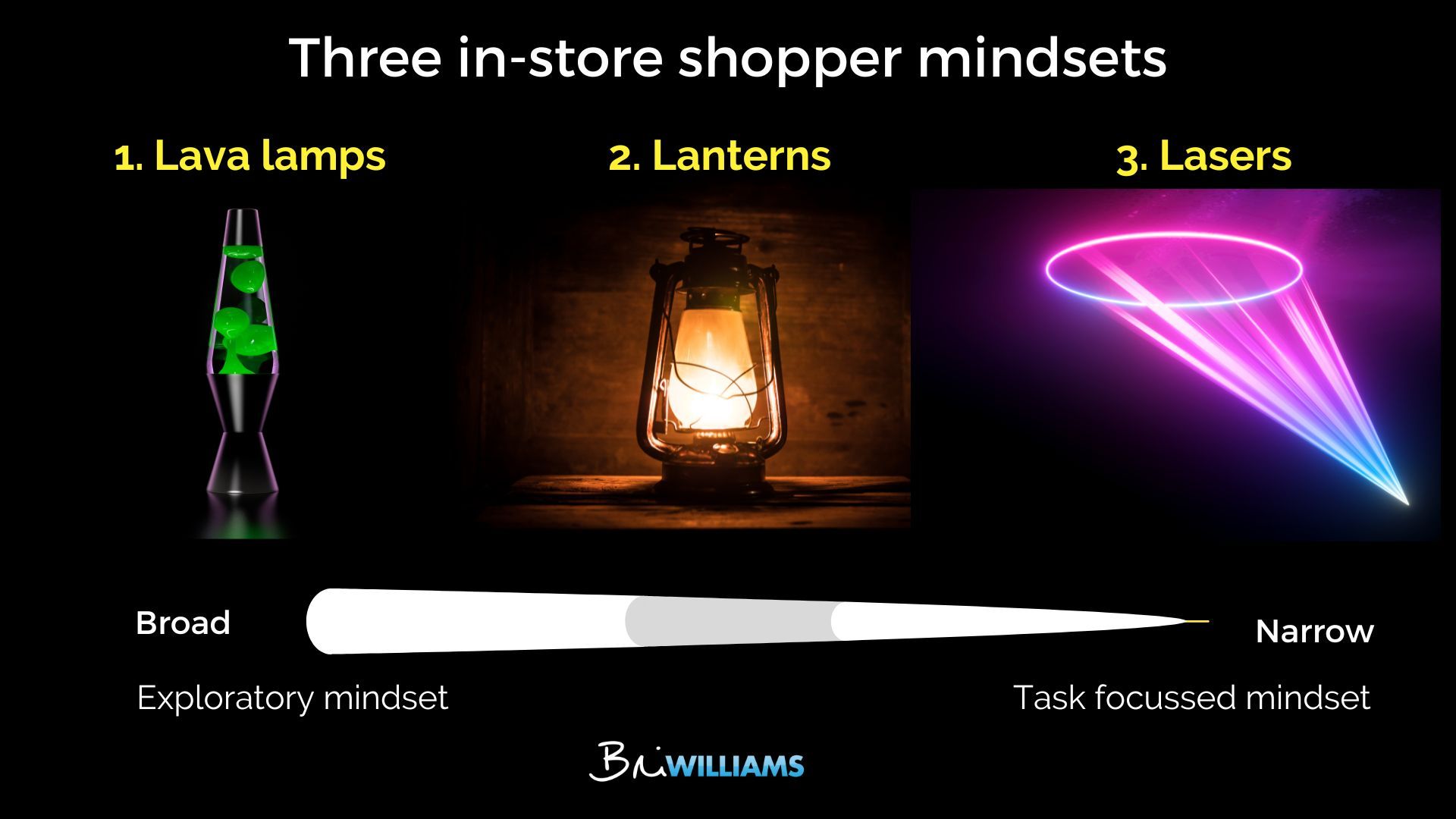3 shopper mindsets

I’m preparing for a keynote to a retail group in a couple of weeks, so I’ve been thinking about how they can better engage with in-store shoppers.
As I see it, there are three shopper mindsets that vary according to task orientation:
- Lasers,
- Lanterns and
- Lava Lamps.
I’m using light as the metaphor to represent how diffused their focus is.
At one end of the task orientation scale, Lasers are laser focussed on what they need to buy. They want to get in and get out, so don’t get in...
The importance of customer touch
Haptics is the information we seek and gain through touch.
It’s why we reach out and feel the fabric of a garment, or run our hand over a piece of furniture.
We see haptics put to use in the film What Women Want, where the marketing team are given a box of products to play with, spurring their imagination.
But does touching a product actually work?
Yes.
It does two things:
- Increases ownership, making your customer feel it’s theirs.
- Fuels imagination, helping them imagine using it. ...
Dislodging status quo
There’s only one reason why your customers aren’t buying.
Status Quo Bias.
Which means I have some good news and bad news for you.
The bad news? For them, doing nothing is better than doing something. Choosing not to proceed is better than proceeding.
The good news? Now that you know that we can do something about it.
Take this ad from Apothecary, for example. They’re trying to replace using wine to wind down with their herbal remedy.

So, what are they doing well, and what should they...
How to increase clicks +17%

Rounded buttons generate between 17-55% more clicks than angular buttons.
Across 8 experiments, researchers found buttons with curved or rounded edges generated significantly higher clicks than sharp edges.
Why? Rounded shapes are associated with friendliness and harmony, where sharp edges signify threats and strength.
To reduce your customer's fear of proceeding, round your buttons.
And for more ways to improve the results you get in your business, Just Do This.
Ref: Dipayan Biswa...
The unchangeable core of marketing

A software firm increased email open rates by 20% and sales leads by 31% and a financial services training company increased engagement by 10%.
How?
If you were one of 400 senior marketers at Intuit Mailchimp’s From Here:To There conference, you already know the answer.
In one case it had to do with adding CEO to the sender’s address and in another, a first name to the subject line.
If you are curious about what else I covered, marketing news site B&T have just recapped highlights from m...
You're already doing it

You cannot NOT influence.
👇 👇👇
I talk a lot about influencing skills and how to get customers and colleagues to take action, but here’s the funny thing.
You cannot NOT influence. You're already doing it.
In every interaction – every email, text, phone call, meeting or presentation, you are stimulating a reaction.
You are influencing your audience in some way.
So the question isn’t whether you are influencing, it’s whether you are influencing the desired reaction?
👉 If customers or col...
Behavioural black box

When trying to get people to respond to you, does it sometimes feel like this?

Things get lost in translation.
The email you write doesn’t get opened.
Your website doesn’t compel them to click.
Your pitch doesn’t convert.
Something strange happens between your message and their response.
The behavioural black box.
![]() Imagine being given the keys to the box?
Imagine being given the keys to the box?
![]() Imagine seeing what’s inside.
Imagine seeing what’s inside.
![]() Imagine designing work that translates to the desired action.
Imagine designing work that translates to the desired action.
That’s what I’d like to give you....
How to cross-sell using completion bias
What does a jigsaw puzzle have to do with selling?
Researchers successfully used visual representations of a jigsaw to sell more wine and more banking products.
We can encourage customers to buy more products across our range by changing the way we visually represent them.
In this video I explain:
- How to visually represent your product suite
- What completion bias is and why it's so powerful
- How an online retailer and bank used these techniques to drive sales
How to get a customer to proceed
Customer not interested in proceeding?
When persuading customers, your work is less about moving them TOWARDS something, and more about getting them to MOVE AWAY from something else.
To get someone to buy, for example, we need to move them away from not having the product at all or using a competitor’s.
That means not only talking up the benefits of our product - but planting the seed that they’ll be worse off if they don’t proceed. That they’ll be going backwards!
For example, “Sounds...
The science of effective Lead Magnets
Should you require people to provide an email so they can download a brochure from your website?
In this video behavioural expert Bri Williams shares the pros and cons for requiring an email from your customer, and how to do it well.
More about Just Do This: www.briwilliams.com/about-just-do-this

